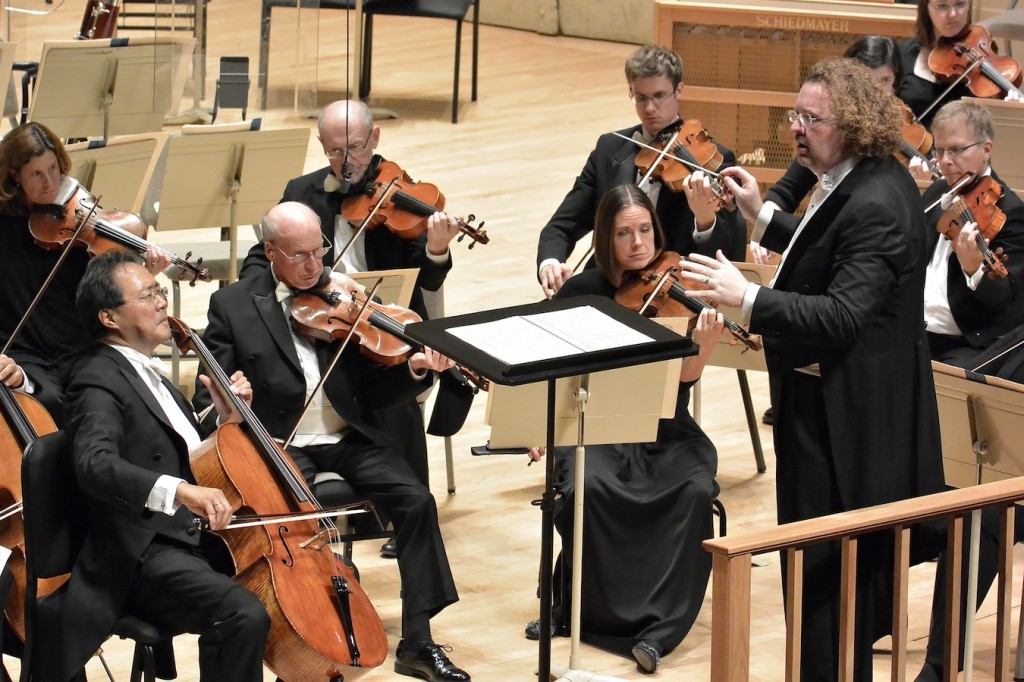Ma’s riveting Shostakovich leads the way with BSO

Yo-Yo Ma performs Shostakovich’s Cello Concerto No. 1 with Stephane Deneve and the Boston Symphony Orchestra Thursday night. Photo: Stu Rosner
The most dramatic thing that happened during the Boston Symphony Orchestra’s performance of Strauss’s Ein Heldenleben Thursday night was the baton flying out of conductor Stéphane Denève’s right hand, describing a graceful arc over his head, and landing in the first row of the audience.
During the few bars of music that it took the maestro to reach down and retrieve the errant stick from a helpful onlooker, the well-drilled orchestra continued its crescendo without him.
But what was a virtue in a conductorless emergency proved a vice in the rest of the performance, as the orchestra’s athletic, efficient rendering of the piece seemed to take little account of the baton-equipped conductor’s exhortations to nuance and expression.
Instead of diving into Strauss’s world of sentimentality and excess, as they have shown themselves capable of doing on other occasions, the proper Bostonians held back, preferring to put on a sonic spectacular worthy of one of our local high-end audio manufacturers. One could almost see the flicker of the LED meters on the stage walls.
Bright spots in this chilly landscape included some characterful horn playing by James Sommerville, Malcolm Lowe’s virtuoso turn in the long, extravagant violin cadenza, and Lowe’s coming back to add much-needed warmth to the work’s closing pages.
Happily, the earlier part of the evening offered greater musical rewards, including a long-delayed, worth-waiting-for Boston deuxième and a not-much-delayed-but- nonetheless-welcome appearance by a local favorite, the Cambridge-based cellist Yo-Yo Ma, in a riveting performance of Shostakovich’s Cello Concerto No. 1, Op. 107.
Somehow, one imagined that, because of the familiarity of its droll March movement, the little six-movement suite Prokofiev made from his opera Love for Three Oranges must be a staple of the repertoire. But as it turns out, according to the performance history in the program, Thursday’s performance was the first by the BSO of the entire suite since Serge Koussevitzky conducted the U.S. premiere in 1926.
Tackling an unfamiliar score together, conductor and orchestra seemed to collaborate more successfully here than later in the Strauss, producing a suitably brittle, energetic, and lucid portrait of the composer as a young modernist.
Although Prokofiev, composing the opera on a commission from Chicago, claimed to have toned down his ear-splitting, age-of-steel style for the American audience, Thursday’s mostly fast-and-furious performance was not lacking in hissing and thumping percussion, screeching strings, and piercing piccolo.
The exception was the fifth movement, “The Prince and the Princess,” a gauzy, Debussy-like love scene that blossomed into more passionate music à la Romeo and Juliet, topped off by Richard Svoboda’s creamy, nostalgic bassoon solo.
Cello concertos are often vehicles for warm sentiments (think Dvořák or Elgar), but the first concerto Shostakovich wrote for his close friend Mstislav Rostropovich was predominantly dry and ironic in tone, as befitted two Soviet artists functioning in a world of repression and concealment.
Accordingly, the usually demonstrative Ma wore his poker face for much of the performance, coolly barking out the concerto’s staccato main theme, leaving it to the listener to guess whether the underlying emotion was humor, anger, or something else.
Of course, irony is itself a form of expression. If there was any doubt of that, one had only to contrast Ma’s nervous, biting phrases with the orchestra’s comparatively bland responses—an early indication that the other players were beginning to sit back for the night.
It’s hard for a horn to play as incisively as a stringed instrument, but Richard Sebring did his best to live up to his program billing as a featured soloist, energetically trading phrases with Ma for large portions of the first movement.
The emotional shoe was on the other foot at the opening of the second movement, with the orchestral strings amply producing the indicated “espressivo” and Ma responding with utmost simplicity and restraint. The Russian-inflected second theme, however, brought out at last the kind of intense, overtly expressive playing that the cellist’s fans came to hear.
The arc of simplicity to deep expression was even higher and broader in the vast solo cadenza, the level of emotion building steadily even as Ma took all the time he wanted, turning over each phrase and letting the pauses reverberate.
Finally the cadenza picked up speed, the finale got under way, and Ma delighted the audience again by getting physical with the crackling Allegro con moto. Bending tightly over his 1733 Montagana, he had the priceless instrument pinned in something like a wrestling hold by the furious final pages.
It was Ma as cello hero, and it proved to be a hard act to follow, even by a piece about “a hero’s life.”
The program will be repeated 1:30 p.m. Friday and 8 p.m. Saturday and Tuesday. bso.org; 617-266-1200.
Posted in Performances
Posted Oct 05, 2013 at 9:40 pm by jim
The suite from “Love For Three Oranges” did become a staple of the repertoire, but it was a staple of Arthur Fiedler’s repertoire. He even recorded it and the recording is still available. I suspect that once the Pops picked it up it became radioactive for the BSO.